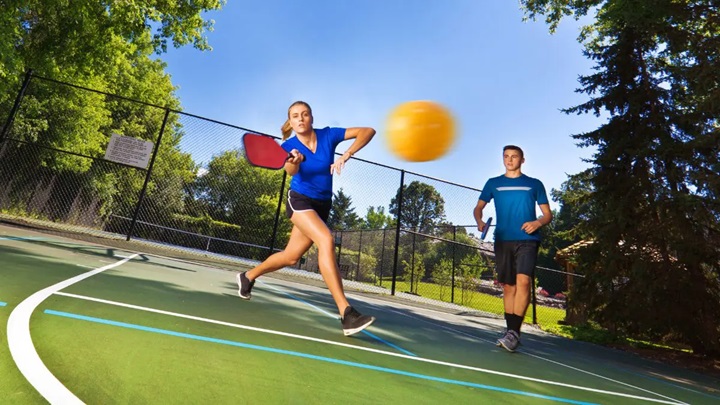From Novice to Pro: Essential Pickleball Training Techniques

Pickleball has rapidly grown in popularity, blending agility, strategy, and skill into a game that’s fun and competitive. Whether you’re just starting or aiming to compete at higher levels, the path to improvement involves mastering fundamental techniques, refining intermediate skills, and honing advanced strategies. This guide provides everything you need to progress from a novice to a pro on the pickleball court.
Building a Strong Foundation
Starting with the basics ensures a steady platform for growth. Establishing proper habits from the beginning will save time and frustration as you advance in the sport.
Grip and Stance
The way you grip the paddle affects your control and versatility. The continental grip, commonly adopted by beginners and pros alike, is a flexible choice that simplifies switching between forehand and backhand shots. At the same time, your stance should be balanced and athletic—keep your feet shoulder-width apart, knees slightly bent, and weight centered. This position prepares you to react quickly to any situation.
The Art of Dinking
Dinking, or soft shots that land delicately in your opponent’s kitchen, is essential for controlling the pace of the game. Beginners often underestimate this skill, but learning to dink with precision and finesse can turn the tide of a match. Practice controlled, short swings to land the ball exactly where you want it while maintaining a neutral stance. Repeated dink drills will sharpen accuracy and build confidence near the net.
Refining Intermediate Skills
Once you’ve mastered the basics, it’s time to add complexity to your game. At this stage, understanding strategy and improving consistency are vital.
Perfecting Your Serve
A good serve sets the tone for each rally. Focus on consistently placing the ball deep in your opponent’s court. Experiment with varying speeds and spins to keep your opponent guessing. For instance, a spin serve can add unpredictability, while a fast, flat serve applies immediate pressure. Repetition during training ensures you can reliably make effective serves under game conditions.
Commanding Court Positioning
Court awareness is critical for tactical play. After serving or returning, aim to reach the Non-Volley Zone (commonly called the kitchen) quickly. This area gives you better opportunities to control the points and respond effectively to dinks or volleys. Practice moving efficiently across the court with lateral drills to improve your positioning and footwork.
The Importance of the Third Shot Drop
A well-executed third shot drop neutralizes your opponent’s attack and puts you in control of the rally. The goal is to hit a soft, controlled shot that lands just inside their kitchen, making it difficult to respond aggressively. Whether in practice or casual games, honing this touch-based skill will elevate both your strategy and execution.
Advanced Techniques for Competitive Play
At advanced levels, the focus shifts to refining precision, building power, and outthinking your opponent. These techniques prepare you for high-stakes matches.
Sharpening Reflexes at the Net
Fast exchanges at the net demand stellar reflexes and quick decision-making. Practice volley drills to improve your reaction time, precision, and paddle control. Use partner drills to simulate rapid dink or block scenarios, building the muscle memory required for success during competitive play.
Power and Spin as Offensive Tools
While accuracy is essential, adding power and spin to your shots gives you a significant edge. Use your body mechanics—generate power from your core and shoulders rather than relying solely on your arm. Topspin shots, for example, keep the ball low and challenging for opponents to handle. Conversely, slicing can create unpredictable bounces, keeping your rivals on their toes.
Strategy and Anticipation
A strong mental game is as important as physical skills. Learn to anticipate your opponent’s moves by observing their paddle angle, body posture, and footwork during play. Preemptively adjusting your positioning or shot can give you a tactical edge. Develop strategies tailored to your strengths while exploiting your opponent’s weaknesses for maximum effectiveness.
Physical Conditioning for Success
To maintain consistency during long matches, prioritize physical fitness. Work on agility through lateral drills, endurance through cardiovascular exercise, and strength with resistance training. A balanced conditioning routine not only boosts performance but also helps prevent injuries.
Practice and Consistency
Improvement in pickleball relies heavily on regular practice. Revisit the foundational skills periodically while dedicating time to mastering more advanced techniques. Incorporate drills that target specific areas of improvement, like spin serves or reflex-based volleys. Playing full matches with varying opponents allows you to test your skills in real-time scenarios and adapt to diverse playing styles.
Tournament participation can further accelerate your progress. Facing tough competition challenges you to refine skills under pressure and prepares you for higher-level play.
The Importance of Staying Updated
Pickleball continues to evolve with new strategies, regulations, and equipment advancements. Staying informed about these updates can give you a competitive edge. Following the news about pickleball through various resources and participating in clinics or workshops can help you stay updated and elevate your game. Remember, learning is a continuous process, and staying informed ensures you’re always equipped with the latest knowledge to improve your skills.
Conclusion
Pickleball is an engaging and dynamic sport that requires a combination of physical skill, mental acuity, and strategic thinking. Mastering the basics sets the foundation for growth, while consistent practice and refinement of advanced techniques are necessary for success at competitive levels. Stay updated on new sports developments to constantly improve and adapt your game. With dedication and hard work, anyone can become a skilled pickleball player.






